
* From the early 1930s, Soviet aircraft designer Georgiy Mikhailovich Beriev developed a series of flying boats for the USSR, with his organization still in that line of work. This document describes Beriev flying boat designs up to the 1960s, most notably the "Be-6", "Be-10", and "Be-12". It also provides a survey of flying boats developed by the Tupolev organization in the prewar period.
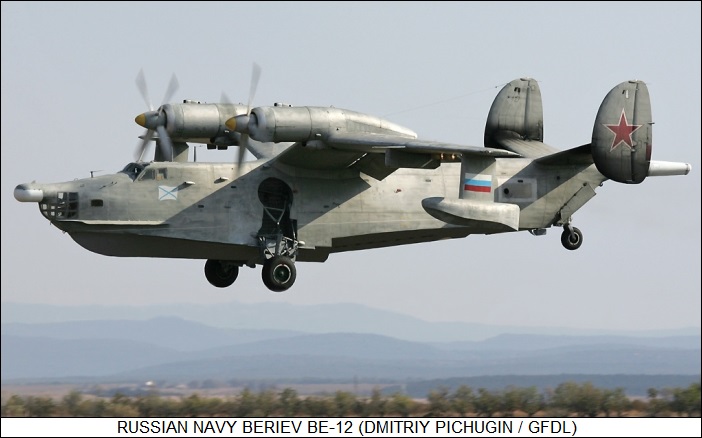
* In the late 1920s, Georgiy Beriev was a design engineer at the Soviet Central Aerodynamics & Hydrodynamics Research Institute (TsAGI in its Russian acronym) in Moscow. In 1930, he was posted to Taganrog on the Sea of Azov to work on license production of an Italian-design Savoia-Marchetti flying boat; from this experience, he came up with a design for his own flying boat, and in 1931 asked the authorities for permission to proceed on it.
The initial prototype of the new flying boat, designated simply "Aircraft Number 25", proved successful in trials, and so it was ordered into production as the Beriev "Marine Short-Range Reconnaissance (Morskoi Blizniy Razvedchik) 2" or just "MBR-2". It was a tidy monoplane flying boat of mostly wooden construction and a crew of three, including a pilot, a nose gunner, and a rear gunner. Both gunners were armed with a single PV-1 7.62-millimeter (0.30-caliber) machine gun on a flexible mount.
The MBR-2 could carry up to 500 kilograms (1,100 pounds) of external stores, such as bombs or depth charges, on external racks. It was powered by a Mikulin M-17B water-cooled vee-12 engine, with 545 kW (730 HP), mounted on struts on the back of the aircraft to keep it out of the water. The M-17 was derived from the German BMW VI engine, which had been used to power the prototype.
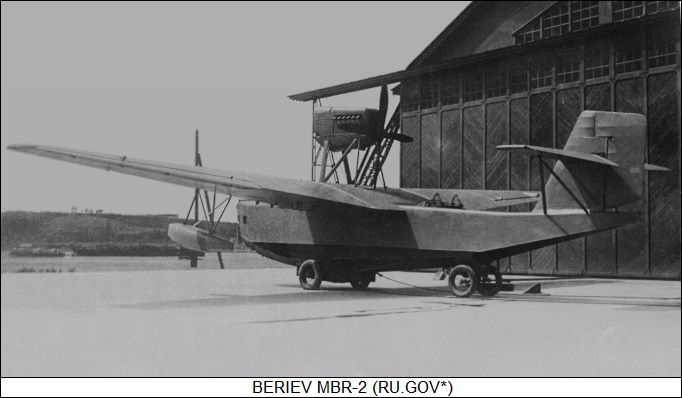
Service deliveries began in 1934. The initial production variant appears to have been basically an evaluation type. In 1935 Beriev rethought the design, altering the tail, providing a glassed-in cockpit and glassed-in position for the rear gunner, updating the armament to ShVAK 7.62-millimeter machine guns, and in particular changing the engine from the M-17B to the Mikulin AM-34B, a new-design liquid-cooled vee-12 engine with 620 kW (830 HP). The new version was designated the "MBR-2/AM-34", to distinguish it from the original "MBR-2/M-17". Some sources also give the updated model the designation of "MBR-2bis", where "bis" is Latin / French for "encore", roughly translating as "plus".
___________________________________________________________________
BERIEV MBR-2/AM-34:
___________________________________________________________________
wingspan:
19 meters (62 feet 4 inch)
wing area:
55 sq_meters (592 sq_feet)
length:
13.5 meters (44 feet 4 inches)
height:
4.4 meters (14 feet 9 inches)
empty weight:
2,720 kilograms (5,990 pounds)
MTO weight:
4,245 kilograms (9,360 pounds)
max speed at altitude:
275 KPH (170 MPH / 145 KT)
service ceiling:
4,900 meters (16,100 feet)
range:
1,500 kilometers (930 miles / 810 NMI)
___________________________________________________________________
The MBR-2/AM-34 was produced in quantity, providing creditable service through the Second World War, and lingering in use for about a decade after the conflict in the fisheries patrol mission. Sources also mention a civilian "Marine Passenger (Morskoi Passazhirskiy) 1" or "MP-1", with no armament and seats for six passengers -- being built in both M-17B and AM-34MB versions -- as well as a number of specialized and experimental variants. Sources give about 1,300 MBR-2 flying boats built in all, making it Beriev's most successful flying boat in terms of sheer production numbers.
Other Beriev seaplanes designed in the 1930s weren't so successful:
The competing design was the Chyetverikov "MDR-6" AKA "Chye-2", along the lines of a scaled-up US Grumman Goose. The MDR-6 was only built in modest numbers, the Red Navy preferring the American Consolidated PBY flying boat during the war -- the type being provided under Lend-Lease military assistance, and also built in the USSR under license as the "GST".
BACK_TO_TOP* Although the MDR-5 didn't enter production, it did provide a basis for a development of a more formidable twin-engine flying boat, the "Be-6", for the maritime patrol and antisubmarine warfare (ASW) roles. Development began in 1943, leading to initial flight of a prototype, the "LL-143", in 1945. Refinement and enlargement of the LL-143 design led in turn to the initial flight of the first production in February 1949, the type entering service in 1950.
The Be-6 was reminiscent of the American Martin PBM Mariner flying boat, with twin radial engines, a twin-fin tail, and a gull wing -- gull wings being advantageous in a flying boat, because they kept the engines as far out of the water as possible. However, the Be-6 was clearly not a copy of the Mariner, being different in detail appearance and slightly larger. It was of metal construction, except for fabric-covered ailerons and rudder, and featured a compartmentalized interior to help keep it afloat after being damaged. It was powered by Shvetsov ASh-73TK 18-cylinder two-row air-cooled radials, with 1,790 kW (2,400 HP) each.
___________________________________________________________________
BERIEV BE-6:
___________________________________________________________________
wingspan:
33 meters (110 feet)
wing area:
120 sq_meters (1,292 sq_feet)
length:
23.5 meters (77 feet 1 inch)
height:
7.64 meters (25 feet 1 inch)
empty weight:
18,825 kilograms (41,505 pounds)
MTO weight:
29,000 kilograms (64,000 pounds)
max speed at altitude:
415 KPH (255 MPH / 220 KT)
service ceiling:
6,100 meters (20,000 feet)
range:
5,000 kilometers (3,100 miles / 2,700 NMI)
___________________________________________________________________
Defensive armament consisted of twin NR-23 23-millimeter cannons in remote-control tail and dorsal turrets, or four cannon total; sources also mention an NR-23 on a flexible mount in the nose position, but it appears it was deleted early on. The Be-6 could carry up to four tonnes (8,800 pounds) of ordnance, such as depth charges, torpedoes, or mines, on underwing stations; illustrations show a station inboard and outboard of the engine on each wing. It could also haul a relief crew; or up to 40 troops in an assault transport role; and of course could be used for the search and rescue (SAR) mission. It could extend a search radar radome from the rear fuselage.
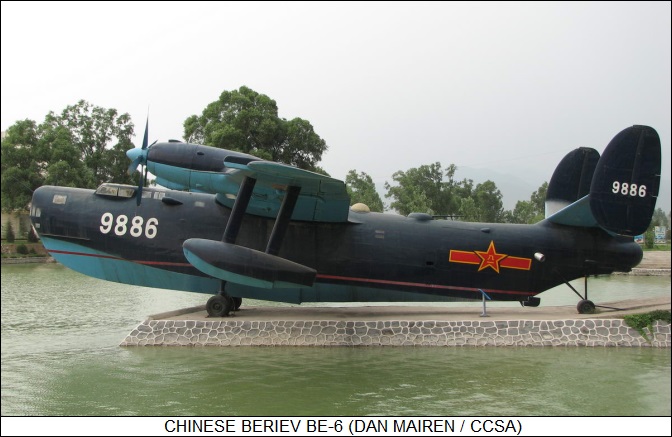
Sources give total Be-6 production as about 150 aircraft, all built at Taganrog -- a handful apparently being provided to Aeroflot, the Soviet civil airline service, as transports for Arctic service. It was assigned the NATO reporting name of "Madge". From the mid-1950s, Be-6 aircraft in Red Navy service were given an updated equipment fit, most notably with the tail turret removed and replaced by a magnetic anomaly detector (MAD) boom for the ASW mission. In its updated guise, the Be-6 was the first Soviet aircraft properly optimized for the ASW mission to go into operational service.
The Be-6 remained in production to 1957 and in military service into the early 1970s, lingering for a few years after that in the fisheries patrol mission. The Chinese also obtained a number of Be-6 aircraft, updating survivors with Wojiang WJ-7 turboprop engines in the 1970s.
BACK_TO_TOP* With the introduction of turbojet engines during World War II, during the postwar period there was a general interest in updating a range of aircraft accordingly. In 1947, the Beriev organization began studies of a jet-powered seaplane, with the development of the "R-1" -- where "R" apparently stood for "Reactivniy (Reaction)", loosely translated as "jet" -- formally initiated in 1948. The prototype performed its initial flight on 30 May 1952, the crew being pilot I.M. Sukhomlin and flight engineer S. Kontratenko.
The R-1 clearly had some design influence from the Be-6, with a similar flying boat hull and high-mounted gull wings, though the two were entirely distinct aircraft. The R-1 was somewhat smaller, had a conventional tail arrangement instead of a twin-fin tail, and was powered by twin VK-1 centrifugal-flow turbojets with 26.5 kN (2,700 kgp / 5,950 lbf) thrust each, the VK-1 being an improved Soviet copy of the British Rolls-Royce Nene. The VK-1 was also used on the famous Mikoyan MiG-15 fighter. The R-1's performance was comparable to that of contemporary jet fighters. Range was modest, early jet engines being notorious fuel hogs, and so the R-1 was intended for coastal operations, not long-range maritime patrol.
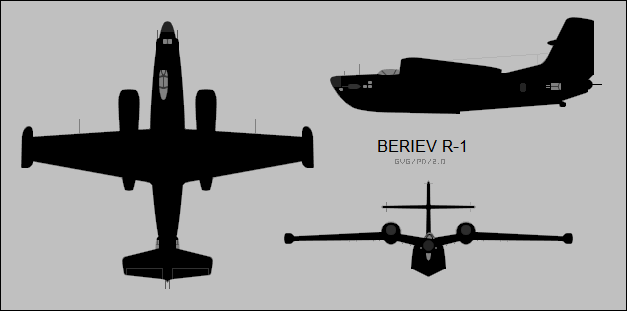
The R-1 was of all-metal construction; it was strictly a flying boat, with no undercarriage except for detachable beaching gear. It carried a crew of three -- navigator / bombardier in the nose, pilot, and radio operator / tail gunner in the rear fuselage. The navigator and pilot got in and out via a door on the right side of the fuselage, behind the cockpit; the navigator also had a top hatch. The pilot sat under a bubble canopy, offset to the left, that hinged open to the right. The tail gunner got in and out through a door on the left side of the fuselage. The pilot and navigator had ejection seats; an inflatable dinghy was provided for crew rescue after ditching.
___________________________________________________________________
BERIEV R-1:
___________________________________________________________________
wingspan:
20 meters (65 feet 4 inches)
wing area:
58 sq_meters (624 sq_feet)
length:
19.9 meters (65 feet 4 inches)
height:
7.1 meters (23 feet 4 inches)
MTO weight:
20,300 kilograms (44,760 pounds)
max speed at altitude:
800 KPH (500 MPH / 430 KT)
service ceiling:
11,500 meters (37,730 feet)
range:
2,000 kilometers (1,245 miles / 1,080 NMI)
___________________________________________________________________
The tailfin had a straight trailing edge and a swept leading edge, with a forward fin fillet. The tailplane was mounted at mid-height on the tailfin, with a bullet fairing at the joint. Flight control surfaces were conventional -- one-piece flaps, split by the engines; ailerons; rudder and elevators; and trim tabs. The flight surfaces and engine inlets were de-iced by engine bleed air; the canopy was electrically de-iced.
Armament included twin fixed foward-firing NR-23 23-millimeter cannon, aimed by the pilot through a gunsight, and a tail barbette with twin Sh-1 23-millimeter cannon, aimed by the tail gunner from blisters on each side of the rear fuselage of the aircraft. Bombs and other stores, up to a tonne (2,200 pounds) total, were carried on stores attachments under the inner wing. The bombardier dropped munitions with an optical bombsight.
Avionics were sophisticated for the era, including radios, identification friend or foe (IFF) transponder, and radio navigation aids. There was a Kurs radar in a nose radome for search and navigation. The R-1 also had a reconnaissance capability, with pivoting film cameras on each side of the fuselage for oblique photography. Interesting minor details included floats that hinged up to the wingtips, plus a pop-open vent on the fuselage at the trailing edge of the wings, which provided venting to the boat hull step. Early trials had shown the R-1's sea handling to be downright terrifying, the aircraft having a vicious tendency to pitch up to the extent of threatening to flip over, or otherwise throw itself to its destruction; the vent did much to tame the beast.
There was thought of going on to a more refined "R-2" seaplane, with uprated VK-5 engines and other improvements, as a step towards production -- but in 1953, the decision was made to move on to a much better next-generation jet seaplane, and so the single R-1 ended up being a technology demonstrator for its successor. The R-1 remained in test and trials for several years, to be finally scrapped in 1959.
BACK_TO_TOP* Work on the improved jet flying boat design, initially given the OKB designation of "izdeliye (product) M", began in late 1953. It was intended for reconnaissance, antiship attack, minelaying, and bombing of naval bases and coastal installations. A full-scale mockup of the "Be-10", as it was officially designated, was available for inspection by the summer of 1954, with hydrodynamic tests performed using a subscale model, deployed from a boom mounted on the front of a torpedo boat racing along the river Don.
The initial prototype performed its first flight from the Black Sea on 20 June 1956, the crew being pilot V.V. Kuryachiy, V.S. Fadeyev, and G.V. Galyatin. State trials began in October 1958, with the first production machine being rolled out in the summer of 1959. Including the prototype, a total of 27 Be-10s were built to 1961. It was assigned the obscure NATO reporting name of "Mallow", after a herbaceous plant, following a flight of the Be-10 at the 1961 Moscow-Tushino air show.
The Be-10 had some broad similarities to the American Martin Seamaster jet flying boat, which had taken to the air about a year earlier. However, the two were entirely distinct aircraft, easily differentiated even by a novice aircraft spotter, being no more than comparable implementations of the same concept. The Seamaster project had begun in 1951, so it is possible that it inspired the Soviets to develop the Be-10, but inspiration is all the Be-10 could have owed to the Seamaster.
Like the Seamaster, the Be-10 was a pure flying boat -- no landing gear except for detachable beaching gear -- of all-metal construction; with all-swept flight surfaces, the high-mounted wings with a strong dihedral and tipped with fixed floats; as well as defensive armament consisting solely of a tail turret. Beyond that, everything else was different, most notably in that the Be-10 was substantially smaller, about two-thirds the empty weight of the Seamaster.
The Seamaster had four engines, mounted on top of the wing -- the Be-10 had two, one mounted under each wing root, the engines being Lyulka AL-7PB turbojets with 72.1 kN (7,350 kgp / 16,210 lbf) thrust each -- the AL-7 also being used with the Sukhoi Su-7 attack aircraft and Su-9 interceptor, the Be-10's AL-7PB variant featuring corrosion-resistant materials for maritime operations. The low position of the Be-10's engines would lead to difficulties in trials. The engines had fire-extinguishing systems and maintenance covers that hinged downward and could be used as work platforms, each engine being started by a small turbine engine running off aviation gasoline, not jet fuel.
The Seamaster had a tee tail; the Be-10's tailplane, featuring a steep dihedral, was mounted at the base of the tailfin. The Seamaster had a conventional side-by-side crew cockpit; the Be-10 had a bubble canopy. Another distinctive feature of the Be-10 were two wing fences on each wing -- a typical design element for swept-wing Soviet aircraft, the fences preventing airflow from "defecting" down the length of the wing.
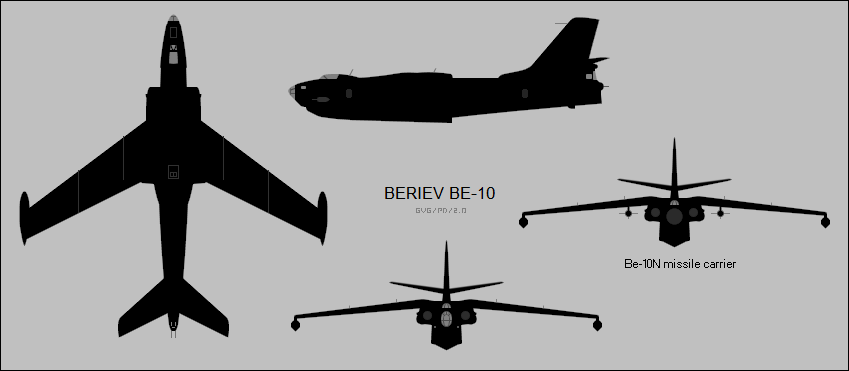
The Be-10's wings had a leading-edge sweep of 35 degrees, the tailfin having the same sweep, plus a leading-edge fillet. The tailplane had a leading-edge sweep of 40 degrees. Flight controls were conventional, including one-piece flaps, ailerons, rudder, and elevators, all flight controls being purely manual. There was a water rudder near the tail. Flight surfaces and the canopy were all de-iced by engine bleed air. There were two bladder-type fuel tanks in the central fuselage and 16 bladder tanks in the wings, with an inert gas system to discourage fuel system fires.
As with the R-1, there were three crew -- navigator / bombardier in the nose, pilot under the bubble canopy, and radio operator / tail gunner in the tail. Crew accommodations were pressurized. The navigator and pilot got into the aircraft from a watertight door on the right side of the forward fuselage; the navigator also had a top hatch, and the pilot's canopy hinged open to the right. The tail gunner had a door to his compartment on the right. The navigator and pilot had ejection seats, the tail gunner got out through a ventral hatch -- ejecting through the tailfin was clearly not an option. The aircraft carried a set of one-man inflatable life rafts and a larger inflatable dinghy.
___________________________________________________________________
BERIEV BE-10:
___________________________________________________________________
wingspan:
20 meters (65 feet 4 inches)
wing area:
130 sq_meters (1,400 sq_feet)
length:
31.45 meters (103 feet 2 inches)
height:
10.7 meters (35 feet 1 inch)
empty weight:
27,640 kilograms (60,950 pounds)
MTO weight:
48,500 kilograms (106,950 pounds)
max speed at altitude:
880 KPH (550 MPH / 480 KT)
service ceiling:
12,200 meters (40,000 feet)
range:
2,610 kilometers (1,620 miles / 1,410 NMI)
___________________________________________________________________
Munitions were carried in an internal weapons bay with watertight bomb bay doors, total warload being up to about 3,000 kilograms (6,600 pounds). There were doors on top of the fuselage for downloading munitions into the weapons bay. The tail turret was fitted with twin AM-23 23-millimeter cannon, the tail gunner directing the weapons with an optical sight and Argon radar. There were also twin fixed AM-23 cannon in the nose, fired by the pilot through a gunsight. Avionics included radios, radio navigation aids, IFF, chaff-flare dispensers, tail warning radar, and a Kurs-M search radar, peering through a radome in the nose under the navigator's position.
Early trials demonstrated the engine intakes had a nasty tendency to gulp up water during sea surface operations; the engines also tended to flame out from gun gas ingestion. As a result, a production machine was refitted with engine intakes that extended forward and up from the previous intake location, while the cannons were fitted with blast gas deflectors to dissipate the gun gas. Trials showed that the extended intakes, to no surprise, choked down airflow and reduced performance, so no other Be-10 had them -- production machines being fitted instead with a prominent "strake" around the nose to deflect sea spray. Even in refinement, the Be-10 was a bit of a handful on sea take-offs and landings, mostly because of its high speed; it was not regarded as an appropriate assignment for a novice pilot.
* The Be-10 was an innovative and impressive aircraft in its way, one stripped-down machine being used to set records for flying boat performance. It wasn't as graceful as the Seamaster, more inclined to the muscular in appearance, as was Soviet preference. It was also a failure, never being formally adopted for operational service. The main problem was that its mission had become irrelevant; while a flying boat would make sense for ASW and SAR operations, the Be-10 was too much for such roles. In addition, the bombing / mining / reconnaissance role could be just as well handled by land-based long-range aircraft and the torpedo-bombing role was simply obsolete.
The Be-10 also had a design defect in that it used an aluminum alloy that was prone to corrosion. Following a crash in August 1961, the tail gunner being the sole survivor, the Be-10 fleet was grounded; the crash was judged due to pilot error, but the analysis revealed the corrosion problem. The Be-10 was formally phased out in 1963, with the survivors parked, and then scrapped in 1968. Sadly, none survived.
A dual-control trainer modification for the Be-10 was developed, but it is unclear if there were any updates of production machines to that configuration. There was also work on an ASW variant; a target spotting variant with an Uspekh radar system to designate naval targets for long-range antiship missile attack; and a "Be-10N" missile carrier, with a K-12 missile under each wing and a bulbous nose radome for targeting radar. None of these variants ever flew. There are tales of a Be-10 in the colors of Aeroflot, but only because of an imaginative image to that effect on a Soviet postage stamp issued in 1965.
BACK_TO_TOP* While the Be-10 project was working its way to eventual extinction, in 1956 Soviet authorities initiated work on an amphibian flying boat, designed from the start for the ASW mission, to replace the Be-6 in that role; the same design would be adaptable to the SAR role. The new flying boat was originally supposed to be powered by Kuznetsov NK-4F turboprops, turboprops providing higher flight speed than piston engines and better endurance than turbojet engines.
The aircraft was assigned the OKB designation of "izdeliye Ye". Progress was slow due to the distraction of work on the Be-10, and the mockup of what had been assigned the service designation of "Be-12" wasn't available until late 1957. The initial prototype was rolled out early in the summer of 1960, with flight trials beginning on 18 October of that year. The first prototype was lost due to pilot error in November 1961, three of the crew being killed; a second prototype was rolled out in September 1962, completing trials in 1965. By that time, the Be-12 was in production, initial examples having been delivered to the Red Navy in 1964. It was given the elegant name of "Chaika (Seagull)"; when the West caught wind of the type, it was given the NATO reporting name of "Mail". A total of 143 of all variants was built at Taganrog up to end of production in 1973 -- it is unclear if that number included the two prototypes.
* The Be-12 was "something old, something new, something borrowed", incorporating lessons learned on earlier Beriev flying boats, with a number of innovations incorporated. It was of all-metal construction, with a high-mounted gull wing, twin tailfins, and tricycle landing gear -- all with single wheels, the main gear pivoting upwards over the boat hull into the sides, the tailwheel pivoting backwards up into the end of the aircraft. It featured fixed floats, a sea rudder at the end of the boat hull, and strakes alongside the nose to deflect seaspray. Trials with the first prototype demonstrated that sea water impacts tended to "ding" the propellers, so a second set of strakes was added lower on the fuselage under the cockpit after initial trials; the prototype's engines had also been underneath the wings, but they were relocated to the top for all following aircraft, for the same reason.
Instead of NK-4F turboprops, the Be-12 ended up being powered by Ivchenko / Progress AI-20D turboprops -- initially Series 3 (-20DK), later Series 4 (-20DM) -- with 3,865 kW (5,180 SHP), driving four-bladed variable pitch propellers. The service doors to the engines hinged down to be used as work platforms. An auxiliary power unit in the rear fuselage provided starting and ground power. Engine bleed air was used to de-ice the flight surfaces and the engine intakes; an electrothermal system was used to de-ice the windscreen, props, and pitot tube.
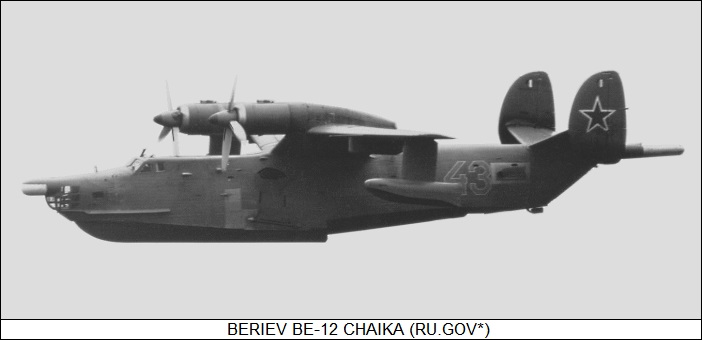
Flight controls were conventional, with ailerons, one-piece flaps (split at the engine), elevators, and rudders, all manually controlled. There was no defensive armament; up to 3,000 kilograms (6,600 pounds) of stores could be carried in a weapons bay, with belly doors behind the hull step, stores including homing torpedoes, depth charges, mines, and sonar buoys ("sonobuoys"). Two stores pylons could be fitted to each wing outboard of the engine for carriage of torpedoes or depth charges -- with two charges per pylon -- but it is unusual to find images of the Be-12 with stores pylons fitted, suggesting they usually weren't in operational service.
___________________________________________________________________
BERIEV BE-12:
___________________________________________________________________
wingspan:
29.71 meters (97 feet 6 inches)
wing area:
105 sq_meters (1,130 sq_feet)
length:
30.17 meters (99 feet)
height:
7.94 meters (26 feet 1 inch)
empty weight:
21,700 kilograms (47,840 pounds)
MTO weight:
31,000 kilograms (68,340 pounds)
max speed at altitude:
610 KPH (380 MPH / 330 KT)
service ceiling:
11,300 meters (37,000 feet)
range:
7,500 kilometers (4,660 miles / 4,050 NMI)
___________________________________________________________________
Crew included pilot, copilot, navigator, and a systems operator -- some sources plausibly give two systems operators. The pilot and copilot sat in a conventional cockpit, with the navigator sitting in nose glazing, and the systems operator in the rear fuselage -- with a dorsal observation dome so he could look around. There were crew entry doors, front and back, on the left side, plus a hatch on top of the nose, and behind the cockpit. The pilot and copilot had ejection seats; the rest of the crew had to get out as best they could. Accommodations were unpressurized, the Be-12 being intended for low-altitude patrol operations. The interior spaces were compartmentalized to ensure flotation after damage.
Flight avionics included radios, navaids, and IFF, while combat avionics included an APM-60Ye (later APM-73S) MAD system, the MAD magnetometer being in a prominent tailboom; an Initsiava-2B search radar in a nose thimble; sonobuoys dispensed from the weapons bay, as mentioned; and a mission computer system. It is unclear if the Be-12 ever had a signals intelligence receiver -- useful for spotting targets from their radio emissions -- or defensive countermeasures. Use of magnetizable metals was avoided in the rear fuselage to prevent interference with the MAD system. In the first prototype, the radar was extended through the forward belly, but the possibility of it becoming stuck led to its relocation to the nose. The first prototype also had a turret with twin 23-millimeter cannon, but the decision was made that, as a coastal patrol aircraft, enemy fighters would be dealt with by other platforms should they attack a Be-12.
BACK_TO_TOP* The Be-12 proved a valuable asset in Red Navy service. It was not a particularly elegant aircraft, but it did have a certain purposeful Soviet appearance. Its performance was good for what it was; early on, a Be-12 was temporarily stripped down to set a number of world records for its class, this machine being designated the "M-12". The Be-12's primary defects were that runway handling was troublesome -- the main gear track was narrow, and the slab-sided fuselage made the Chaika sensitive to crosswinds -- and that it was noisy, making long patrols in it somewhat wearying.
Of the production machines, one was built in the mid-1960s as a "Be-14" SAR aircraft, external differences being the MAD boom bobbed off, additional doors, and the observation blister moved forward; a pop-up searchlight was added to the rear of the blister. A doctor and a flight technician were added to the crew; the aircraft carried rescue kit, such as inflatable life rafts, and could carry a nominal load of 15 passengers, more in overload condition.
Lack of money meant the Be-14 didn't go into production, but the SAR requirement remained. In the early 1970s, near the tail end of Be-12 production, a more modest SAR variant, the "Be-12PS" -- the "PS" standing for "Poiskovo-Spasatelnyi (Search & Rescue)" -- was produced. It didn't have the night rescue capability of the Be-14, and it retained the same basic airframe as the Be-12, but featured extra doors and rescue kit, and had the ability to carry 13 passengers. The stores pylons could be used to carry air-dropped rescue kits. It retained the MAD boom to maintain flight balance. Two stock Be-12 machines were rebuilt as Be-12PS prototypes, with ten built new, plus two more conversions.
In the 1970s, 27 Be-12 machines were fitted with improved avionics -- including the AMP-73S MAD receiver, improved Initsiava-2BN radar, new mission computer, and so on -- and redesignated "Be-12N", where "N" stood for "Narcis (Narcissus)". They were given an improved generation of sonobuoys as well.
There were also a number of Be-12 "special conversions" from early in its service life:
The Be-12 saw little foreign service. Following the 1967 Mideast Six-Day War, in 1968 three Be-12 machines were sent to Egypt to perform patrols. These aircraft were given Egyptian markings, but they were still under Soviet control and had Soviet crews. They came back home in 1971. Four Be-12s were handed over to Vietnam in the early 1980s.
* The Be-12 persisted in first-line Red Navy service through the 1980s, with a few also flown by the Red Air Force to give personnel training in ASW procedures. Following the fall of the Soviet Union, numbers of Be-12 machines in the ranks declined steadily, the Ilyushin Il-18 land-based patrol aircraft taking over the ASW mission. A number of Chaikas ended up in service with the Ukrainian Navy, while several that still had useful airframe life were passed on for Russian civil service:
In the early 1990s, a Be-12 was kitted up as a demonstrator for an environmental survey machine, to be redesignated "Be-12 EKO". Nobody bit on it and it never went any further. A few Chaikas may still linger in service -- but if so, not for much longer.
BACK_TO_TOP* In the prewar period, the Soviet design bureau under Andrei N. Tupolev built a number of flying boats, none of which entered full production, but might as well be briefly discussed here for completeness. The first was the "ANT-8", "ANT" of course standing for its designer -- this aircraft being roughly along the lines of the Beriev MBR-2, but about twice as heavy and with twin vee inline pusher engines, mounted in individual nacelles on struts above the wing. The ANT-8, which had a service designation of "MDR-2", performed test flights in 1931, but it was a demonstrator for larger flying boat designs, not really intended as a production aircraft.
There were a number of concepts for a larger Tupolev flying boat, devised under the designation of "ANT-11", ultimately leading to development of the "ANT-22". This aircraft was something of a grotesque monster, amounting to two large flying boat hulls without cockpits joined together, with a central cockpit pod at midwing, the aircraft being roughly the same weight as the later Beriev Be-6. The ANT-22 was powered by six vee-inline engines, mounted in tractor-pusher pairs on struts above the wing; the right hull had nose, dorsal, and tail gun turrets, while the left hull appears to only have had the dorsal turret -- the armament configuration is very unclear. Munitions were carried in bays in the wing center section and on external racks.
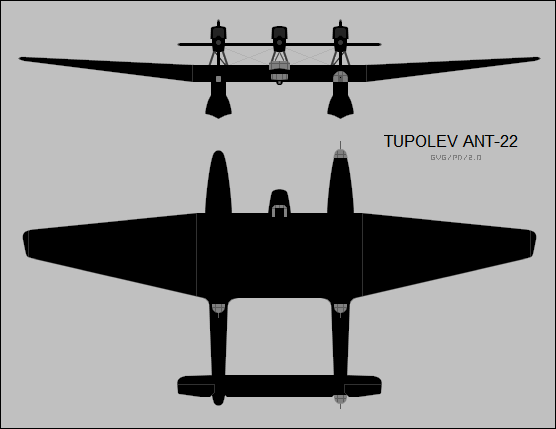
Trials began in 1934, but performance was disappointing; given the complexity of the aircraft, development was likely to be protracted, and it was judged likely to be obsolete by the time it was introduced. The ANT-22 was abandoned. It should be noted that the ANT-22's sea-keeping capability was excellent, that consideration being one of the drivers for the unorthodox twin-hull configuration, and it had an impressive load capability. Its configuration and load capability led to an extremely imaginative proposal for operating the ANT-22 as a mini-submarine carrier.
The idea was that the mini-submarine would be strapped under the flying boat centerline, flown to the vicinity of a harbor, and the mini-submarine sent loose; it could be manned or radio-controlled. After its attack, the mini-submarine would return to the flying boat and be recovered. It's hard to determine whether the idea was brilliant or mad; in any case, it came to nothing. Incidentally, the ANT-22 seemed so well-suited to the "straddle carrier" role, hauling mini-submarines or other large external payloads, that it's tempting to believe it was designed with the straddle carrier mission in mind -- though that doesn't seem to have been the case.
* In the meantime, the Tupolev OKB had "inherited" a flying-boat design generated by Chyetverikov, which was rethought by Tupolev engineers to result in the "ANT-27", with initial flight of the first prototype in 1934. It was broadly similar to the ANT-8 but about twice as heavy, with three inline engines mounted high on struts instead of two -- the center engine being of pusher configuration, the others of tractor configuration.
The first prototype crashed, killing three of its crew, within a week of its first flight, but a second prototype, the "ANT-27bis", was quickly finished to perform trials. It crashed, too, but the ANT-27 did go into modest production, with 15 built as either "MDR-4" patrol aircraft or "MTB-1" bombers. Notions for a 14-seat airliner version were not followed up. The service history of the ANT-27 is very obscure, the type apparently being retired after a few years of service.
The last of the Tupolev flying boats was the most impressive of the lot. In 1934, the Short Brothers firm of the UK, well-known for its flying boats, had offered to sell the USSR a leading-edge long-range flying boat design. The Soviets gave the idea a looking-over, to conclude that the Tupolev OKB should develop such a flying boat, using the Short proposal as a starting point. The basic design of the "ANT-44" was in hand by 1935, with flight of the first prototype in 1937.
The ANT-44 was remarkably similar to the famous Short Sunderland flying boat, being a tidy modern design with four radial engines, plus nose and tail turrets. It was by no means a "clone" of the Sunderland, the ANT-44 prototype having flown several months before the Sunderland, and the two machines had visible differences -- the ANT-44 being most notably distinguished by its gull wing, as opposed to the flat wing of the Sunderland.
The first prototype was lost in early 1939, sinking after its hull ruptured in a hard landing. A second prototype, the "ANT-44bis", flew later in that year, the trials going well. The design was clearly promising and preparations were made for production as the "MTB-2". However, second thoughts set in, with the ultimate decision being that land-based aircraft could fulfill the mission requirements, and production was canceled -- a bit of a sad end for such a fine-looking aircraft. The ANT-44bis set a number of performance records and performed in combat after the German invasion in 1941, to be finally lost in 1942, for reasons not clear in sources.
BACK_TO_TOP* I wrote this document intending to cover all the Beriev flying boats, but though I thought it wouldn't run into too much detail, in fact it did. I decided to split it in half, to cover early and modern Beriev flying boats in separate documents.
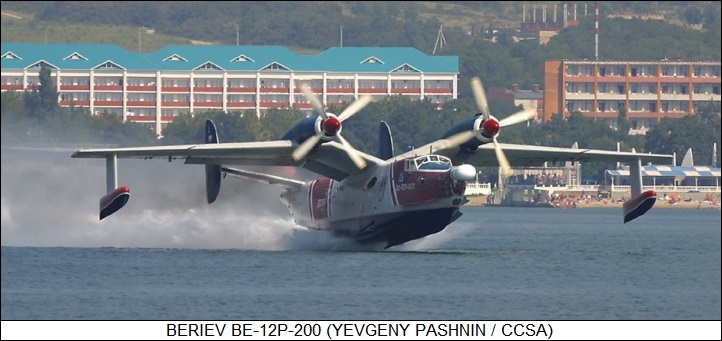
* Sources include:
Online sources, particularly Wikipedia, were consulted for the MBR-2 and Be-6. They are not very well documented.
* Revision history:
v1.0.0 / 01 jun 13 v1.0.1 / 01 may 15 / Review & polish. v1.0.2 / 01 apr 17 / Review & polish. v1.0.3 / 01 mar 19 / Review & polish. v1.0.4 / 01 jan 21 / Review & polish. v1.0.5 / 01 nov 22 / Review & polish. v1.0.6 / 01 sep 24 / Review & polish. (+)BACK_TO_TOP
